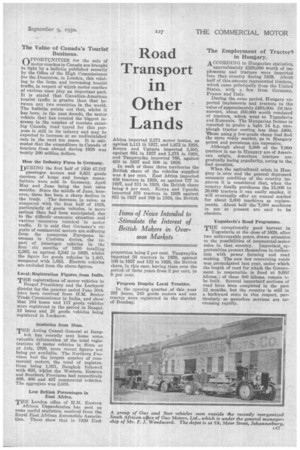Road Transport
Page 69

If you've noticed an error in this article please click here to report it so we can fix it.
in
Other
Lands
The Value of Canada's Tourist Business.
OPPORTUNITIES for the sale of motor coaches in Canada are brought to light by a bulletin published recently by the Office of the High Commissioner for the Dominion, in London, this relating to the large and increasing tourist traffic, in respect of which motor coaches of various sizes play_ an important part. It is stated that Canadian-American tourist traffic is greater than that between any two countries in the world. The bulletin points out that, whilst it has been, in the past decade, the motor vehicle that has created the biggest increase in the number of tourists entering Canada, road travel for this purpose is still in its infancy and may be expected to increase at an undiminished rate in the next ten years. It is estimated that the expenditure in Canada of tourists from abroad during 1929 was nearly 300 million dollars.
How the Industry Fares in Germany.
DURING the first half of 1930 47,787
passenger motors and 8,821 goods carriers of home and foreign manufacture were sold in Germany, April May and June being the best sales months. Since the middle of June, however, there has been a sharp decline in the trade. The decrease in sales,as compared with the first half of 1929, particularly of goods vehicles, is more serious than had been anticipated, due to the difficult economic situation and various Imeasures inimical to motor traffic. It is said that Germany's exports of commercial motors are suffering from the numerous European, increases in Customs duties, the export of passenger vehicles in the first six months of 1930 totalling 2,393, as against 2,542 in 1929, whilst the figure for goods vehicles is 1,405, compared with 1,653. Electric vehicles are excluded from the above figures.
Local t Registration Figures from India.
THE registrations of motor vehicles in Bengal Presidency and the Luchnow district for the quarter ended June 30th have been received from H.M. Senior Trade Commissioner ikk India, and show that 164 buses and 117 goods vehicles were registered in the period in Bengal, 18 buses and 26 goods vehicles being registered in Lucknow.
Statistics from Siam.
THE Acting Consul General at Bang kok has recently sent home some valuable information Of the total registrations of motor vehicles in Siam as at July, 1929, more recent figures not being yet available. The Northern Province had the largest number of commercial motors, the total of registrations being 1,021, Bangkok followed with 635, whilst the Western. Eastern and Southern Provinces had respectively 489, 466 and 427 commercial vehicles. The aggregate was 3,038.
Low British Percentages in East Africa.
TUE London office of U.M. Eastern African, Dependencies has sent us some useful statistics, received from the Royal East African Automobile Association. These show that in 1929 East Africa imported 2,271 motor lorries, as against 1,111 in 1927, and 1,875 in 1928, Kenya and Uganda imported 1,505, against 661 in 1927 and 1,375 in 1928, and Tanganyika imported 766, against 450 in 1927 and 500 in 1928.
In each of these three territories the British share of the vehicles supplied was 4 per cent. East Africa imported 436 tractors in 1929, as against 727 in 1927, and 511 in 1928, the British share being 4 per cent. Kenya and Uganda imported 378 tractors in 1929 against 621 in 1927 and 889 in 1928, the British ' proportion being 3 per cent. Tanganyika imported 58 tractors in 1929, against 106 in 1927 and 122 in 1928, the British share, in this case, having risen over the period of three years from 2 per cent. to 9 per cent.
Progress Despite Local Troubles.
In the opening quarter of this year 207 buses, 245 goods motors and one tractor were registered in the district of Bombay.
The Employment of Tractor3 in Hungary.
ACCORDING to Hungarian statistics, approximately £220,000 worth of implements and tractors were imported into that, country during 1929. About half of this amount represented tractors, which came principally from the United States, with a few from Germany, France and Italy.
During the same period, Hungary exported implements and tractors to the value of approximately £470,000. Of this amount, about £50,000 worth consisted of tractors, which went to Yugoslavia and Rumania. The Hungarian farmer is reported to prefer a light 14 h.p. twoplough tractor costing less than 1400. Those usingia low-grade cheap fuel find the more ready market, as in Hungary petrol and petroleum are expensive.
Although about 5,000 of the 7,000 tractors in use in Hungary are of American origin, American tractors are gradually losing popularity, owing to the fuel question.
When the agricultural crisis in Hungary is over and the general depressed economic condition of the country improves it is considered that, when the country finally purchases the 15,000 to 20,000 tractors it can easily employ, it will eventually offer an annual market for about 2,000 machines as replacements. About half the '7,000 machines in use at present are said to be obsolete.
Yugoslavia's Road Programme.
THE exceptionally good harvest in
Yugoslavia at the close of 1929, after two unfavourable years, draws attention to the possibilities of commercial-motor sales in that country. Important_opportunities present themselves in connection with power farming and road making. The new law concerning roads was promulgated last year, under which the length of road for which the Government is responsible is fixed at 9,68't kiloms.; of these 500 kiloms. remain to be built. Several important sections of road have been completed in the past 12 months, but the country is still irk a backward state in this respect, particularly as motorbus services are increasing rapidly.












































































































